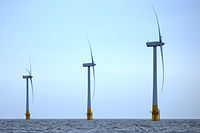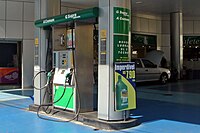Economy of Tagmatium
Overview
The economy of Tagmatium is a developed mixed economy and one of the largest economies on Eurth, with a GDP of $5.553 trillion, and a GDP per capita of $20,665.. Tagmatum's economy has a reliance on heavy heavy industry and agriculture, as well as a growing biofuels and alternative energy sector. A well-established armaments sector also helps bolster the economy, with many systems being sought out by other nations on Eurth. Due to the ancient and well known history of Tagmatium and the Aroman Empire, tourism plays a large role, with visitors coming from all over Eurth, visiting both ancient and modern, secular and religious sites and attractions. Whilst Tagmatium does have a leading regional manufacturing sector, with an element of automation, it lags behind this when compared to the wurld's other leading economies. Tagmatium holds the wurld's largest share in the biofuel market, being the largest grower of the raw material, the largest producer and largest exporter of the biofuel itself. This goes hand-in-hand with the fact that the country is also the largest producer and exporter of grain on Eurth. The manufacture of textiles is the leading Tagmatine light industry, using wool or plant fibres often grown within the Greater Holy Empire's borders. This sector, as well as agriculture and construction, tend to provide low-skill, low-paying jobs for much of the Tagmatine workforce.
Most trade Tagmatium undertakes with other nations is in Europa but the Holy Imperial Government has been pursuing trade deals with New Wurld nations, including Iverica, Delamaria, Seylos and Salvia. These are based on a reciprocal reduction in tarriffs and are often targeted to improve Tagmatium's agricultural and environmental sectors. Tagmatium also maintains a customs union with Adaptus, called the Aroman Customs Union.
Natural Sector
Within the farming sector, staple crops such as maize, wheat, barley and rye are predominant, with Tagmatium being the largest exporter of grain on Eurth. Much of this is exported to other Europan countries but some also goes further afield, to Argis and Alharu. This goes hand-in-hand with Tagmatium's booming biofuels industry. The problem this has begun to pose is that there is competition for arable land between crops such as wheat or maize and crops used for seed oil. Farming sees a high degree of automation, although this is often seen in the large farming combines that dominate the growing of these staples for exports – smaller, family owned farms often cannot afford the newer generation of machinery and, as a result, are often not as profitable as the larger-scale farms. The areas of Tagmatium that see the highest production of grain are the Megale Agrotikon and Transmireia regions, although all areas apart from the extreme north of the country have a signficiant proportion of land turned over to the production of grain. Sugar beet is also a common crop, used for both animal feed and alcohol production. The agricultural industry is overseen by the Ministry for Agriculture.
Besides arable farming, sheep and cattle are raised, both for meat, dairy produce and wool. Much of this is consumed within Tagmatium but wool, as a base for textiles, is exported. Seed oil is the biggest growing sector within the Tagmatine agricultural sector, aided by subsidies and the fact that the government is actively seeking foreign markets for it. This sector also provides much of the luxuries that Tagmatium exports – Tagmatine wine, brandy and whisky are amongst the most famous, as well as more niche products such as garos, a fermented fish sauce. Although much of Tagmatium has a humind continental climate, part of the Sinuusan Desert forms the southwest of Tagmatium and the climate there enables the production of saffron, which historically formed part of the revenue of the Holy Emperor and its export was tightly controlled. Now, it is exported across the wurld.
Forestry is tightly controlled by the Ministry of the Environment, which also monitors many aspects of the impact of agriculture as a whole. Much of this control comes from legislation based on the historic need to supply wood for weaponry and charcoal for metalworking for the Taggmatine armed forces, to protect the nation from its perceived enemies. Although this need is long since redundant, it has installed an ethos that forms part of the drive of Kommodos III's government towards a sustainable future. Logging and the utilisation of forests and woodlands for commercial uses is strictly licensed and monitored, with unlicensed activity punished through fines and occasionally prison sentences.
Industrial Sector
The industrial sector of Tagmatium is helped by a good supply and variety of natural resources, including abundant deposits of iron, copper, coal, zinc and even some rarer ores, such as bauxite, tungsten and uranium. The country's well-developed infrastructure of roads – famously, metaphorically so – and rail aids extraction and use of these resources, but international competition means that much of this is limited to central and northern Europa. Shipbuilding, farming machinery and locomotive construction are the largest parts of the industrial sector, whilst the automotive industry tends to lag behind foreign examples.
The arms industry supplies the needs of the Tagmatine Armed Forces, with everything from small arms to armoured vehicles and most ship types domestically produced, with some exported to allied or at least friendly nations. These include Aurivizh, Nyantastan and Zaxar. The arms industry is considered to be key to the nation's security, which means that the government is often not keen on foreign companies becoming involved in the sector. This has also meant that much of it is under the control of the state, either as directly state-owned or companies in which the government holds a majority share.
Tagmatium's automotive industry includes several large manufacturers, such as Basilikoi Kinitires and Hippokomos, that produce a range of vehicles, from cars to heavy goods vehicles. Much of the industry was state-owned until the mid 1990s when it was privatised.
Tagmatium's commercial electronics and software development is good for northern Europa but cannot be described as wurld-beating – at times, the indigenous companies do little more than play keep-up with foreign competitors. This has become somewhat reinforced by recent trade deals struck by the Agios Basilikon Kounsistorion with Salvia and Iverica, which reduced the tariffs for foreign imports in this sector. Examples of the local manufacturers are the mobile phone brands EtVade and Kosmos. The video game industry has seen a growth in recent years, with several companies being founded and receiving investment from venture capitalists and grants from the government. The biggest companies are Dynapyr Entertainment and Exsite Games.
Due to Tagmatium's booming agricultural sector, the production of industrial chemicals for fertiliser and pesticide has seen a similar upswing, at least within the internal market. Recent trade deals secured by the Holy Imperial Government have opened up swathes of the international market to agricultural chemicals produced in Tagmatium, with many nations in the New Wurld now utilising them.
Service Sector
The service sector remains a bit more rudimentary than other comparable national economies, more focussed on the internal market than the international one. This is partially due to the nascent state of the Tagmatine electronics sector but it is also hindered by other factors. These include a language and culture that doesn't spread much beyond the Occident and north-eastern Amutia, despite increasing interest in the projection of soft power by the Tagmatine government.
Healthcare is provided by a mixture of the state and the Church, with most hospitals, hospices and residential care being run administratively by a diocese but staffed by employees of and funded by the Ministry of Health. There is some varience, however. Private healthcare exists but is rare and is usually only accessed by the wealthy.
Hospitality is a major part of the service sector, providing a wide range of low-paying jobs. Food service is split between restaurants, which includes everything from the high end to fast food, to bars, taverns and pubs. Hotels can be much more varied, from luxurious ones that cater to foreign and domestic tourists to those that cater almost exclusively towards pilgrims travelling between the various shrines and religious sites in Tagmatium. These are often as part of a pilgrimage route and are usually quite spartan. In between lie ones that cater business travellers.
The Tagmatine merchant fleet has been able to take advantage of the continental economic downturn and step into the void formed by other countries no longer being able to maintain extensive merchant fleets of their own. This has been aided by the favourable rates the Agios Basilikon Kounsistorion offers on transit through the Isthmus Canal to shipping firms registered within Tagmatium. It has meant that the Tagmatine merchant fleet has come to become the leading freight service within the Raga and the Central Europan seas.
Tourism
Tourism remains a steady sector – the ancient sites and sights of the Aroman Empire draw tourists from across Eurth, whether to see such storied sites as the Walls of Konstantios that dominate Europatorion and various ancient Christian sites that dot the country. The capital cities are the most visited parts of Tagmatium, although the popularity of the north of the country for winter breaks is increasing. There were some 45 million visits to the country in 2019. Another draw are the unspoilt landscapes in many parts of the nation, as well as the mountains in the north that provide opportunities for activities such as skiing and mountain climbing.
The continental economic downturn has seen a reduction in tourists from Europa but increasing contact with the New Wurld means that much of this has been replaced by tourists from Marenesia, Argis and Aurelia. Tagmatium has become a popular destination for tourists from Kirvina especially, as the use of Laimiaic in that Aurelian nation means that there are fewer language barriers for tourists visiting the Greater Holy Empire. Tourism is being encouraged by both the Ministry of Culture and the Ministry of Finance through the inter-ministerial working group Visit Arome.
Transport
The road network of Tagmatium has its roots dating to the famous roads of the ancient Aroman Empire, although the modern road system bears little resemblance to that system. The road network is well developed, with XXX miles of paved roads connecting all settlements in the country. There is also an extensive motorway system, consisting of over XXX miles, which links all of the major cities of Tagmatium. Although the country represents one of the largest automobile markets in the wurld, due to the size of the nation, a recent study by the Ministry for Transport stated that there were 353 vehicles per 1,000 people.
The majority of public transport services, such as bus, tram, light rail and the underground systems of Europatorion, Tagmatika and Dymafos, are state-owned and overseen by either the municipal authorities or the districts that they are based in. There are also inter-province bus services but these are not as popular as rail travel. In 2018, there were 20.2 billion bus journies within the Greater Holy Empire, of which 5.3 were in Europatorion alone. The largest city of Tagmatium has one of the most extensive bus networks in Europa, if not the Eurth, with over 6,5000 services scheduled each weekday, carrying roughly five million passengers over 600 different routes. The green buses are considered to be iconic in Tagmatium.
The Greater Holy Empire's rail network is amongst the longest in the wurld, with a length of XXX miles, and it radiates out from several large cities in the nation, such as Europatorion. It serves both a freight- and passenger-carrying role, although a slow increase in automobile-ownership means that passenger numbers have been on a downward trend in recent years. The railways are all state-controlled, apart from rail lines that operate within large mines, quarries or industrial sites. The state-owned rail network is operated as Aroman Railways, a state-owned conglomerate that came into being during the Long War as a way of coordinating the various rail companies in had previously operated in Tagmatium. The rail network is nearly all standard gauge, apart from some light railways and tramways. Most settlements, from large cities to small villages, are connected to the rail network, although the latter may be served by a station that also serves other villages in the area. Although Aroman Railways has a reputation for being somewhat unreliable at times, the low cost of rail fares compared to the expense of vehicle ownership has meant that travel by rail is still the most popular method of travel within the Greater Holy Empire. The interconnectedness of all of the major settlements has also long been an economic boon for businesses and industries as well.
The civil airline industry is a mixture of private and state-owned, with the flag carrier Aroman Airways being state-owned and its next largest competitor, Occidental Air, privately owned and fulfilling a niche as a low-cost domestic and international carrier. The largest, and busiest, Tagmatine airport is Europatorion Airport, which handles over one hundred million passengers a year, with several other airports, such as Tagmatika and Dymafos, handling tens of millions a year.
Energy
Tagmatium is one of the top five largest energy consumers on Eurth and ranks amongst the top ten for energy production. It is also home to what was once one of the largest oil and gas companies on Eurth, Aroman Petroleum.
Much of Tagmatium's power needs are provided through renewable sources or through nuclear power generation, with as much as 68% being met by wind and hydroelectric power. Previously, energy was mainly generated by power stations fueled by fossil fuels, as well as several nuclear power stations, recent drives during the reign of Kommodos III has seen the power grid transition to renewable sources. In November 2018, the country was able to fulfil all of its energy needs for a week through renewable and nuclear sources, and this became more the norm throughout 2020. Tagmatium is currently updating or replacing most of its older nuclear power stations, as nuclear power is viewed as key to meeting Tagmatium's future energy needs.
Coal production played a large role in the Tagmatine economy during the 19th and 20th Centuries. However, towards the end of the 20th Century, cheaper foreign coal became much more economically viable and Tagmatine production was scaled back in favour of these imports. Although Tagmatium is still a large-scale exporter of coal, it is down from the 100 million tonnes of the late 1900s, down to roughly 30 million tonnes, with indicators that this may reduce further. The Ministry of Power estimates that the coal reserves within the nation could last, at current rates of extraction, for between 200 and 400 years. However, if the downward trend of coal extraction continues, this figure could increase. It is also estimated that the there are significant oil and gas fields underneath the ocean floor around the Hermitage Islands but the Holy Imperial Government has not indicated any intent to exploit them, nor published figures relating to their size.
The sector that is booming in Tagmatium is biofuel and it is becoming the main fuel for automobiles within the nation. This is primarily due to efforts by the Holy Imperial Government to encourage it as an alternative fuel source to fossil fuels, through environmental concerns about the use of fossil fuels. This has been encouraged through both tax breaks and subsidies for the construction of infrastucture, production and useage of biofuels, as well as an increase on levies on petrol and diesel. Critics have, however, pointed out that biodiesel and other biofuels are not truly "green" in nature - they are, at best, carbon neutral, since their use still emits greenhouse gases into the atmosphere and their production directly competes with the use of arable land for other crops. Electric vehicles and those powered by hydrogen are also becoming more common, although the infrastructure is not yet in place to support them to the level of the other options. Investment and research is being encouraged by both the automotive industry and the Tagmatine government and includes several universities and car manufacturers.









